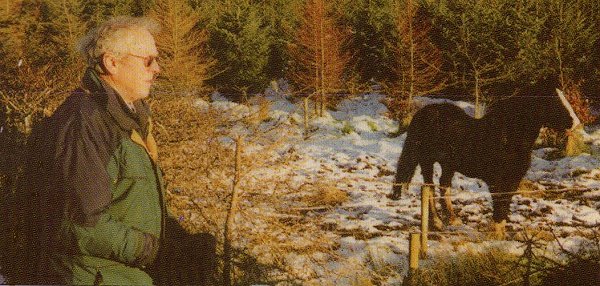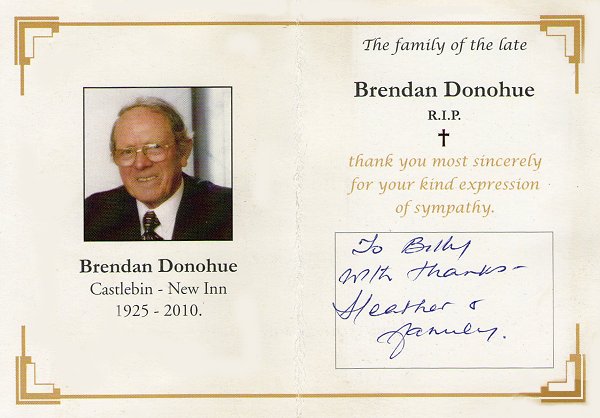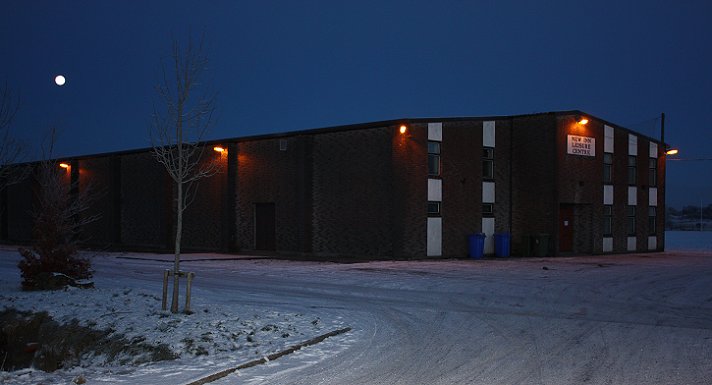In Memory of Brendan Donohue
(Castlebin, New Inn, Ballinasloe, County Galway)
May He Rest In Peace
November 21st 2010
| Like as the waves | ||
|
Like as the waves make towards the pebbled shore, So do our minutes hasten to their end; Each changing place with that which goes before, In sequent toil all forwards do contend. Nativity, once in the main of light, Crawls to maturity, wherewith being crown'd, Crooked elipses 'gainst his glory fight, And Time that gave doth now his gift confound. Time doth transfix the flourish set on youth And delves the parallels in beauty's brow, Feeds on the rarities of nature's truth, And nothing stands but for his scythe to mow: And yet to times in hope my verse shall stand, Praising thy worth, despite his cruel hand. |
||












|
"Those who die in Grace go no further from us than God. |
|||||||||||||||||||||||||||||
|
And, God is always very near." |
|||||||||||||||||||||||||||||
|
|||||||||||||||||||||||||||||
|
(Please click on the www link just above for infomation and performances relating to the Song) |
|||||||||||||||||||||||||||||
|
Amazing Grace Lyrics
|
|||||||||||||||||||||||||||||
|
|||||||||||||||||||||||||||||
|
"An Slí Mór" |
||
|
("The Ten Thousand Year Old Great Highway") |
||
| "They (the Celts or Keltoi as the ancient Greeks called them) also befriended and adapted large herds of horses, and built up a "partnership" with them which remains very strong to this day; and, the Celts were possibly the very first group of people to master the art of horse riding: which would have given them several huge advantages over all other groups living at that time." | ||

|
Killann Cemetry |
||||||||||||||||||||
|
(On the The Esker Riada) |
||||||||||||||||||||
| Some may be interested to know that Brendan Donohue's
final resting place is in
Killann Cemetery, which is located
more or less right on top of the ten thousand year old Esker Riada ("An Slí Mór"
in Celtic, and "Via Magna" in Ecclesiastical Latin:
both of which mean "The Great Highway")
at a distance of
approximately two miles to the North-East of New Inn Village. The
name "Killann", which means "Ann's Church" in the Celtic
language, suggests the site has probably been in use since sometime
well before the Anglo Norman Invasion of Ireland
in 1169 AD. Previous to that time, Christianity in Ireland was dominated by the
Celtic Christian Monks living under
Brehon Law, and women often held senior
positions within the largely autonomous, self-supporting,
and loosely-bound
Céle Dé ("Partners of God")
Celtic Monastic Settlements. Such settlements often included married
couples and their children, and it was upon them that "Celtic Christianity"
-- symbolised by the unique shape of the
Celtic Cross which represented what was, in reality,
much closer to a 50/50 "merger"
than to a complete takeover of either one by the other, between the spiritual (as
in "non-material") beliefs and values associated primarily with the
Celtic Sun God Lugh (through the inclusion of the Circle), and the
fundamental
Teachings of Christ (represented by the inclusion of the Cross) -- was based,
thrived upon, and which spread all over Ireland, and deeply into
the islands and the mainland of Western Europe during the
so-called "Dark Ages" of the second-half of the first
millennium AD, and for some time after that period. Among the
most important and influential of these female Celtic
Christian leaders was the circa 6th century AD
Saint Gobnait who had close links with the Aran Islands
in Galway Bay: among several other places all over Ireland
(and perhaps beyond) that involved parts of County Clare, Ballyvourney in County
Cork, Dún Chaoin in West Kerry, and possibly
Chapelfinnerty in East County Galway. As there are numerous places in Ireland named "Killann" (and similar, such as "Killanne" and "Killiney" for example), it seems likely that there must have been considerable interest in Ireland at one time in Christ's Grandmother (Mary's Mother), who according to the ancient traditions of both Christianity and Islam was Saint Anne. Another possibility is that there was an Irish "Saint Anne" -- of the "Saint Gobnait" calibre referred to above -- whose history has now been entirely lost, or is at least no longer at all well known in present-day Ireland. A very small section of what is believed to have been one of the walls of "Ann's Church" can still be seen in Killaan Cemetery (New Inn) on one of the sides of the site, now a mixture of "old and new" structures, nearest to Ballinasloe Town. One of the largest and best known of the "Céle Dé ("Partners of God") Celtic Christian Settlements" is Clonmacnoise (founded in 545 AD), which developed into what is believed to have been the world's first major "Christian University". In its heyday, it is understood to have attracted students from as far away as present-day Russia. |
||||||||||||||||||||
| Clonmacnoise went into decline following the Anglo Norman Invasion of Ireland of 1169 AD, and not very long afterwards the original buildings ended up in the ruined state they are in today. By the mid 1600s Brehon Law had also been fully stamped out all over Ireland, and replaced by Roman Law. | ||||||||||||||||||||
|
||||||||||||||||||||
| That Time of Year | ||
|
That time of year thou mayst in me behold When yellow leaves, or none, or few, do hang Upon those boughs which shake against the cold, Bare ruin'd choirs, where late the sweet birds sang. In me thou seest the twilight of such day As after sunset fadeth in the west, Which by and by black night doth take away, Death's second self, that seals up all in rest. In me thou see'st the glowing of such fire That on the ashes of his youth doth lie, As the death-bed whereon it must expire Consumed with that which it was nourish'd by. This thou perceivest, which makes thy love more strong, To love that well which thou must leave ere long. |
||
|
William Shakespeare |
||
|
|
|
Winter Solstice (Northern Hemisphere), December 21st 2010: |
|
With New Inn (County Galway) Leisure Centre, which is located on the Esker Riada, in the Foreground. |
